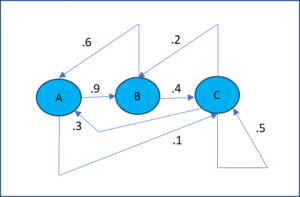In a Markov chain process, there are a set of states and we progress from one state to another based on a fixed probability. Figure 1 displays a Markov chain with three states. E.g. the probability of transition from state C to state A is .3, from C to B is .2 and from C to C is .5, which sum up to 1 as expected.
Figure 1 – Markov Chain transition diagram
The important characteristic of a Markov chain is that at any stage the next state is only dependent on the current state and not on the previous states; in this sense it is memoryless.
Topics
References
Fewster, R. (2014) Markov chains
https://www.stat.auckland.ac.nz/~fewster/325/notes/ch8.pdf
Pishro-Nik, H. (2014) Discrete-time Markov chains
https://www.probabilitycourse.com/chapter11/11_2_1_introduction.php
Norris, J. (2004) Discrete-time Markov chains
https://www.statslab.cam.ac.uk/~james/Markov/
Lalley, S. (2016) Markov chains
https://galton.uchicago.edu/~lalley/Courses/312/MarkovChains.pdf
Konstantopoulos, T. (2009) Markov chains and random walks
https://www2.math.uu.se/~takis/L/McRw/mcrw.pdf
